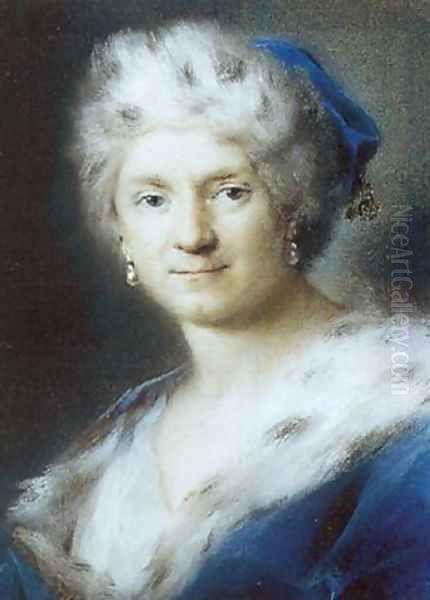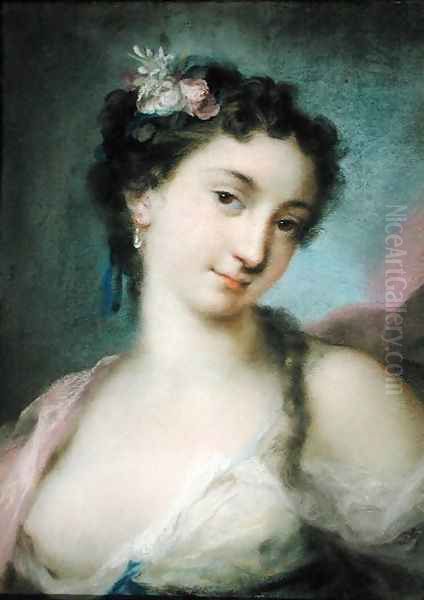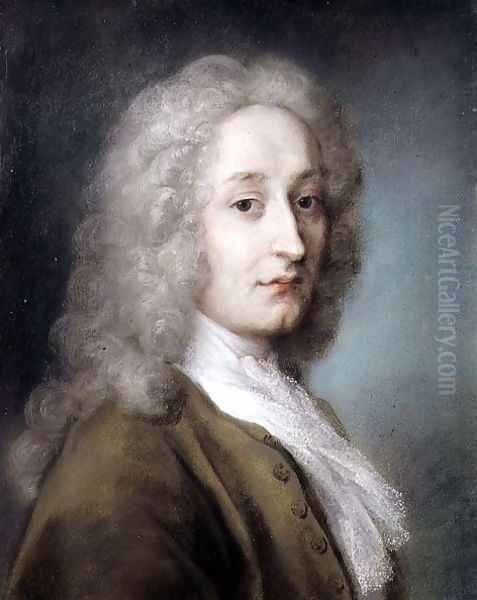
Rosalba Carriera stands as one of the most significant and celebrated artists of the early 18th century. A Venetian by birth and spirit, she rose to international fame through her mastery of the pastel medium, transforming it from a tool for preparatory sketches into the preferred medium for aristocratic portraiture across Europe. Her delicate touch, flattering likenesses, and astute navigation of the art world made her not only a key figure of the Rococo era but also a trailblazing female artist who achieved unprecedented success and recognition in a field overwhelmingly dominated by men. Her life and work offer a fascinating glimpse into the artistic culture of Venice and the courts of Europe during a period of refined elegance and shifting tastes.
Venetian Roots and Early Artistic Formation
Born in Venice in 1673 into a family of modest standing – her father a clerk and her mother a skilled lacemaker – Rosalba Carriera's artistic journey began not with paint, but with thread. Instructed by her mother, she initially gained proficiency in the intricate art of lace design. This early training likely instilled in her a sensitivity to delicate detail and fine craftsmanship, qualities that would later define her painterly style. As the Venetian lace industry faced decline, Carriera, possibly encouraged by her family or mentors, turned her talents towards painting, initially focusing on a related art form: miniature painting.
Venice, her native city, was a vibrant artistic hub. While the monumental history painting traditions of the Renaissance and Baroque, exemplified by artists like Titian and Tintoretto, still cast a long shadow, the 18th century saw a shift towards more intimate, decorative, and lighthearted styles. The city itself, a center for tourism and elaborate festivals, fostered a demand for portraits, genre scenes, and views (vedute) captured by artists like Canaletto and Francesco Guardi. It was within this environment that Carriera began her artistic career, finding an early niche decorating the lids of ivory snuffboxes with exquisite miniature portraits, a fashionable accessory among the elite.

Her skill quickly garnered attention. These tiny, detailed likenesses, often painted in gouache on ivory, required immense precision and a delicate hand. This work not only provided income but also served as a crucial stepping stone, honing her skills in capturing likenesses and handling fine detail. It is believed she may have received some instruction from Giuseppe Diamantini and Antonio Balestra, though her primary development seems largely self-driven, absorbing influences from the Venetian painters around her, perhaps including the tenebrism and expressive faces found in the work of Giambattista Piazzetta, albeit translated into a much lighter key.
The Ascent of Pastel
While successful as a miniaturist, Carriera's true innovation and the foundation of her international reputation lay in her adoption and elevation of the pastel medium. Pastels, essentially pure pigment bound with a minimum of gum arabic and rolled into sticks, had been used since the Renaissance, often for preparatory studies or informal sketches by artists like Federico Barocci. However, Carriera recognized their potential for finished portraiture, particularly their ability to render soft textures, luminous skin tones, and subtle gradations of color with unparalleled immediacy and freshness.
She developed a distinctive technique, applying the pastel dust with her fingers, stumps (rolled paper or leather), and brushes onto paper, often choosing tinted papers (especially blue or grey) which provided a mid-tone base, enhancing the vibrancy of the applied colors. She layered the pigments skillfully, achieving remarkable effects of light, shadow, and texture, capturing the sheen of silk, the fluffiness of powdered hair, and the delicate blush of a cheek. Unlike oil painting, which required lengthy drying times and complex layering of glazes, pastels allowed for rapid execution, enabling her to satisfy the demands of patrons, including Grand Tourists eager for a memento of their visit.
Her pastel portraits quickly became highly sought after in Venice. They offered a flattering softness and intimacy that perfectly suited the emerging Rococo aesthetic, moving away from the formality and grandeur of Baroque portraiture associated with artists like Hyacinthe Rigaud in France. Carriera's ability to capture not just a likeness but an air of graceful elegance and sensibilité resonated deeply with her clientele. Her success was such that by 1704, she was admitted as an 'accademico di merito' to the prestigious Accademia di San Luca in Rome, a significant honor, especially for a non-Roman and a woman, granted on the basis of a submitted miniature.
Miniatures: An Enduring Specialty

Even as her fame as a pastelist grew, Carriera continued to produce exquisite miniatures on ivory throughout her career. These small-scale works were not merely a stepping stone but remained an important part of her output, valued for their intimacy and portability. Often serving as diplomatic gifts, tokens of affection, or personal keepsakes, these miniatures showcased her meticulous skill on a different scale. The smooth, luminous surface of the ivory provided an ideal ground for the detailed rendering of features, jewelry, and elaborate costumes.
Her miniatures, like her pastels, reflected the Rococo sensibility. They depicted sitters with elegance and charm, often against simple, atmospheric backgrounds. The techniques learned in miniature painting – the precise control, the delicate application of color, the understanding of how light interacts with a smooth surface – undoubtedly informed her work in pastel, contributing to the refinement and detail that characterized her larger portraits. This dual mastery made her exceptionally versatile and appealing to a wide range of patrons.
Conquering Paris: International Stardom
The turning point in Carriera's career, catapulting her from Venetian celebrity to international stardom, was her triumphant visit to Paris from the spring of 1720 to the spring of 1721. Accompanied by her mother, sisters, and brother-in-law, the painter Antonio Pellegrini (husband of her sister Angela), she arrived in a city that was the undisputed center of European fashion and art. Pellegrini himself had commissions there, providing an entry point into the highest artistic and social circles.
Carriera's arrival coincided with the regency period and the ascendancy of the Rococo style, of which Paris was the epicenter. Her pastel portraits were a revelation. French artists like Joseph Vivien had worked in pastel, but Carriera's technique, with its softness, luminosity, and flattering grace, seemed perfectly attuned to the prevailing taste. She was welcomed enthusiastically by the Parisian art world and aristocracy. The great collector Pierre Crozat became a key supporter, hosting her and introducing her to influential figures.

During her stay, she was extraordinarily productive, creating portraits of the young King Louis XV, the Regent Philippe II Duke of Orléans, and numerous members of the nobility and financial elite. Critically, she formed a friendship with Jean-Antoine Watteau, the preeminent French Rococo painter, whose fêtes galantes captured the era's blend of elegance and melancholy. They reportedly exchanged portraits; Carriera's sensitive pastel portrait of Watteau (now lost, but known through engravings) is a poignant image of the ailing artist near the end of his life. This interaction highlights the mutual respect between these leading figures of the Rococo. In 1720, she was elected to the French Académie Royale de Peinture et de Sculpture, a rare honor for a woman and the first for an Italian female artist.
European Acclaim and Noble Patronage
Returning to Venice laden with honors and commissions, Carriera's reputation was now firmly established across Europe. Her Paris success acted as a powerful endorsement, and demand for her work soared. She became the portraitist of choice for visiting dignitaries, Grand Tourists, and European royalty. Her studio on the Grand Canal became a mandatory stop for distinguished visitors to Venice.
Her patrons included some of the most powerful figures of the age. Augustus III, Elector of Saxony and King of Poland, was an avid admirer and collector. He amassed a vast collection of her pastels, over 150 works, which today forms the core of the remarkable Carriera holdings at the Gemäldegalerie Alte Meister in Dresden. Frederick IV of Denmark and Norway also commissioned work, as did the Dukes of Modena. English aristocrats on the Grand Tour eagerly sought portraits from her, contributing to the spread of her fame and the popularity of pastel in England. Figures like King George III of Great Britain would later acquire significant works by her.
This extensive network of high-profile patrons testifies not only to her artistic skill but also to her considerable social adeptness and business acumen. She managed her studio efficiently, often assisted by her sister Giovanna ('Nana') and potentially students, maintaining correspondence and negotiating commissions with clients across the continent. Her ability to deliver portraits relatively quickly, thanks to the pastel medium, further enhanced her appeal to a mobile international clientele.
The Essence of Rococo Portraiture
Rosalba Carriera's art is synonymous with the Rococo style in portraiture. Her works epitomize its key characteristics: lightness, elegance, intimacy, and a focus on refined sentiment. She favored soft, luminous color palettes, dominated by pearly whites, delicate pinks, blues, and yellows. Her handling of the medium was fluid and seemingly effortless, creating surfaces that shimmered with light and captured the textures of skin, hair, silk, lace, and jewels with uncanny verisimilitude.

Unlike the often stern or psychologically probing portraits of the Baroque, Carriera's portraits generally present an idealized vision of her sitters. She emphasized grace, charm, and social poise, often depicting her subjects with gentle smiles and relaxed postures. While some critics have noted a certain lack of deep psychological penetration, her aim was arguably different: to capture the sitter's social persona, their elegance, and their place within the refined world of Rococo society. This approach proved immensely popular, offering flattering and aesthetically pleasing images that celebrated beauty and status.
Her subjects ranged from royalty and high nobility to fellow artists, singers like the famous Faustina Bordoni, and members of the Venetian patriciate like Caterina Sagredo Barbarigo. She also produced numerous self-portraits throughout her career, offering valuable insights into her own self-perception and artistic identity. These self-portraits often employ allegorical guises, such as her famous Self-Portrait as Winter (c. 1731), where she depicts herself bundled in furs, a testament to her creativity and engagement with intellectual themes even within portraiture.
Allegory, Mythology, and Sensibility
Beyond straightforward portraiture, Carriera engaged with allegorical and mythological themes, often blending them with portraiture. She created series representing the Four Seasons, the Four Elements, or the Continents, frequently using portraits of known individuals (or idealized types) to embody these concepts. For instance, the celebrated opera singer Faustina Bordoni was depicted as an allegory of Autumn. These works allowed her to showcase her imaginative powers and cater to the era's taste for intellectual conceits presented with decorative flair.
Her allegorical figures, like her portraits, are rendered with characteristic softness and grace. Works like A Young Lady with a Parrot (c. 1730), while perhaps a portrait, carries allegorical undertones related to feminine education or vanity. She also occasionally depicted mythological figures like Diana or Apollo, always imbued with Rococo elegance rather than classical severity.
Some of her works depicted partially draped or semi-nude female figures, often allegorical or mythological in nature. While handled with delicacy, these works sometimes attracted comment in their time, reflecting the complex attitudes towards the female form and the boundaries for female artists. However, they remained within the bounds of Rococo taste, emphasizing sensuousness and grace over overt eroticism. These works demonstrate her confidence in tackling a wider range of subjects traditionally associated with male artists.
A Network of Influence: Contemporaries and Students
Carriera operated within a rich artistic milieu, interacting with many leading artists of her time. Her friendship with Watteau in Paris was significant, representing a meeting of minds at the forefront of the Rococo. While their mediums and primary subjects differed, they shared a sensitivity to nuance and atmosphere. In Venice, she was a contemporary of giants like Giovanni Battista Tiepolo, whose grand decorative schemes represented a different facet of the Venetian Rococo, and Canaletto, whose vedute captured the city's topography. Pietro Longhi documented the city's daily life in his genre scenes. Carriera's focus on portraiture complemented these other flourishing genres.
She maintained connections with artists across Europe. Her brother-in-law Antonio Pellegrini, a history painter, was an important link. She corresponded with figures like Anton Raphael Mengs, a younger artist who would become a leading figure of Neoclassicism, indicating her awareness of shifting artistic currents even late in her career. While direct competition with other leading European pastelists like Maurice Quentin de La Tour in France or the Swiss artist Jean-Étienne Liotard existed, Carriera carved out a distinct niche with her uniquely Venetian color sense and softer style. De La Tour's pastels often aimed for greater psychological realism, while Liotard was known for his sharp focus and ethnographic interests.
Carriera also played a role as a mentor, particularly to other women artists. She taught her sisters, particularly Giovanna who assisted her closely. Other documented students include Felicita Sartori, who became a successful miniaturist in her own right and worked for a time at the court in Dresden, eventually marrying Franz Joseph von Hoffmann. Luisa Bergalli, Margherita Terzi, and Marianna Carlevaris are also mentioned as pupils or assistants, suggesting Carriera fostered a supportive environment for women pursuing art, helping them navigate the professional challenges they faced.
A Woman Artist in a Man's World
Rosalba Carriera's success was extraordinary, particularly given the significant obstacles faced by women artists in the 18th century. While not the first successful female painter – predecessors like Sofonisba Anguissola in the Renaissance and Artemisia Gentileschi in the Baroque had achieved fame – Carriera operated at a level of international celebrity and financial independence that was exceptional. She achieved this without the traditional support structures often available to male artists, such as extensive workshop systems for history painting.
Her choice of medium was strategic. Pastel and miniature painting were considered more "suitable" for women than large-scale oil painting, yet she elevated these genres to the highest level of artistic achievement and commercial success. She managed her career astutely, leveraging her talent, social connections, and the unique appeal of her chosen medium. Her election to academies in Rome, Bologna, and Paris signified official recognition at the highest levels, breaking barriers for women in these institutions.
Her career paved the way for subsequent generations of successful female artists, such as the Swiss Neoclassical painter Angelica Kauffman and the celebrated French portraitist Élisabeth Vigée Le Brun, both of whom achieved international renown later in the 18th century. Carriera demonstrated that a woman could not only participate in the art market but could dominate a particular niche and achieve widespread fame and financial independence through her artistic talents and professional acumen.
Final Flourish and Tragic Decline
Carriera remained highly productive and sought-after throughout the 1720s, 1730s, and into the early 1740s. She continued to refine her pastel technique, producing some of her most celebrated works during this mature period. Her portraits captured the elite of Europe with enduring charm and elegance, solidifying her place as a defining artist of the Rococo age. Her studio remained a hub of artistic activity in Venice.
Tragically, her remarkable career was cut short by failing eyesight. Around the mid-1740s, she began to suffer from deteriorating vision, likely due to cataracts. Despite undergoing operations, the procedures were unsuccessful, and she eventually became completely blind. For a visual artist, particularly one whose work depended on subtle nuances of color and light, this was a devastating blow. She spent the last decade of her life, from roughly 1747 until her death in 1757, in Venice, unable to paint, living in relative seclusion. It was a poignant end to a life dedicated to visual beauty.
Legacy and Historical Reassessment
Rosalba Carriera's impact on 18th-century art was profound. She was instrumental in popularizing pastel as a major medium for portraiture across Europe, particularly in France, where her influence was strongly felt by artists like Maurice Quentin de La Tour, even if their styles differed. Her work perfectly encapsulated the Rococo aesthetic – its elegance, intimacy, and preference for lighter palettes and graceful forms. She defined the ideal of aristocratic portraiture for several decades.
Despite her immense fame during her lifetime, Carriera's reputation, like that of the Rococo style itself, declined significantly during the Neoclassical and Romantic periods of the late 18th and 19th centuries. Her work was sometimes dismissed as frivolous or superficial compared to the perceived seriousness of history painting or the dramatic intensity of later styles.
However, the late 20th and early 21st centuries have witnessed a significant reassessment of both the Rococo era and Carriera's contribution. Scholars and curators now recognize the technical brilliance, aesthetic sophistication, and historical importance of her work. Renewed interest in female artists has also brought her career into sharper focus, celebrating her achievements as a pioneer who navigated the challenges of her time with remarkable success.
Today, her works are prized possessions of major museums worldwide, including the Gemäldegalerie Alte Meister in Dresden, the Gallerie dell'Accademia in Venice, the Uffizi Gallery in Florence, the Louvre in Paris, the Metropolitan Museum of Art in New York, and the Royal Collection in the UK. Exhibitions dedicated to her art continue to draw attention to her mastery of pastel and her unique place in art history.
Conclusion
Rosalba Carriera remains a pivotal figure in 18th-century European art. As the undisputed mistress of the pastel portrait, she captured the essence of the Rococo era with unparalleled grace and technical skill. Her luminous and flattering likenesses charmed the aristocracy of Europe, securing her international fame and fortune. More than just a successful artist, she was a trailblazer, a woman who achieved extraordinary recognition and independence in a male-dominated profession, skillfully managing her career and leveraging her unique talents. From her early miniatures on ivory to her mature, shimmering pastel portraits and allegories, Carriera's work continues to enchant viewers with its delicate beauty and stands as a testament to her enduring artistry and historical significance.